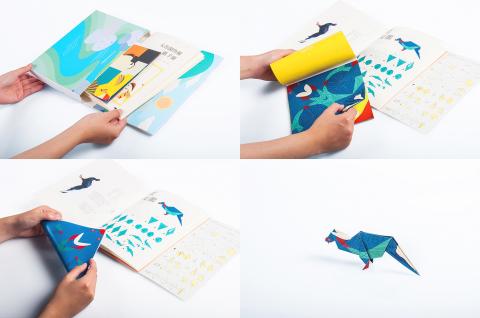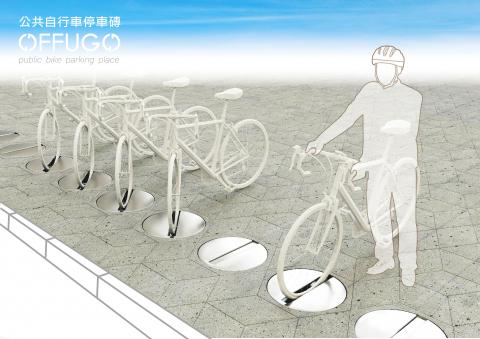Three college seniors have created an innovative bike lock meant to provide more room on Taipei’s congested sidewalks. Offugo (公共自行車停車磚) is an aluminum alloy plate that fits like a manhole cover into the ground and works by pinning a tire to a retractable spine. It doesn’t look like much, but that’s the main attraction.
“Think about YouBike, which uses a special rack on the sidewalk,” said co-inventor Cin Siou-huei (秦秀惠) about Taipei City’s bike rental system. “Take away the bike and that rack is still there, taking up space in a space-poor city.”
“Our lock isn’t a visual or literal block to pedestrians,” she said. “Also, in the end it would be cheaper to switch to this system from the YouBike rack, since all you really need is the disc.”

Photo Courtesy of Shu-te University
Last week, the disc was a big winner at the Young Designers’ Exhibition (YODEX, 新一代設計展) in Taipei, where graduating college seniors from across Taiwan vied for a handful of medals. Offugo beat out 1,160 entries for the gold in Product Design (產品設計類) and a silver in the space solutions category (空間設計類), which received 320 entries.
Chou Jing-heng (周敬恆) took a gold medal in the space solutions category with Boundary into the Plan (邊界突入計畫), a scale model based on an abandoned oil drilling platform in the East China Sea. Chou has done major remodeling, which includes knocking out walls and adding a floor with a gambling casino and resort.
Chou even has a colorful story to go with it. The upstairs entertainment zone is for Chinese tourists and the downstairs chambers are for Taiwanese, who service the resort. The space encourages an economic interaction that could allow Taiwan to “elude domination” by its neighbor across the Strait, according to Chou, 22, who is a passionate observer of current events.

Photo Courtesy of Young Designers’ Exhibition
“Hypothetically, if Taiwan is taken over by China, at least we would still have this place. From here, we can slowly take back the island chains, so long as the Taiwanese spirit is there,” he said.
Meanwhile, two students who took a silver medal in the visual communication design category also had tourists in mind, though they were thinking more in the present.
“In bookstores today you can find good guidebooks on Taiwan, but they introduce sites to visit and places to eat. There aren’t many about daily perplexities that foreigners encounter,” said Hazel Tsao (曹乃云).

Photo Courtesy of Chou Jing-heng
Tsao and schoolmate Chen Hsiao-tzu (陳孝慈) won a silver medal for Taiwanese Manual, three books of advice customized for Japanese, American and Chinese visitors. For example, Japanese tourists are warned that tea sold at convenience stores are usually sweetened — “Teas in Japanese stores are not,” Tsao said, citing her interviews with Japanese subjects — while guests from the US are advised that braziers are not garbage disposals. All the advice is presented together on the page, so that the Japanese reader can see all the questions of Americans and Chinese.
“At first, we thought about separating the manuals by language, but then we thought that if we combined all the information, each nationality can see how other people respond to Taiwan and the manuals can be a point of communion for first-time visitors,” said Tsao.
Other YODEX winners included an origami set by Shu-Te University (樹德科技) — original foldable designs based on Toroko Gorge wildlife — which picked up a silver each from the product and visual communication categories. Some of this origami is quite a challenge and designers said they want to encourage parent-child interaction.
The Missing Piece (缺角的圓), which took a gold medal in the digital multimedia design category (數位多媒體設計), does too. It’s a stop-motion film and each of its 220 seconds uses eight to 24 frames that are photographed one at a time, after tiny adjustments to photographed subjects are made by hand. The star of the show is a miniature doll with movable joints and over a dozen detachable faces that were hand molded, etched and painted. Most of the faces are gloomy.
“She knows her parents won’t be there for her birthday, though she remains hopeful,” said designer Chiu Hung-chieh (邱虹潔). “The film ends with the ring of a door bell, which leaves the issue open-ended. It could be the parents.”
“The film is actually based on my personal experience... My parents watched it and said that I exaggerated, but my sister watched it and cried,” Chiu said. “To an extent, my team members also experienced something similar.”
Stop-motion animation is a visibly unfinished and childlike medium that appeals to adults, her team’s intended audience.
“I think that parents in Taiwan are working hard to earn money to give their children better material circumstances, and they leave their children to nannies. What I’m trying to say to them is that a home needs its people,” she said.

May 6 to May 12 Those who follow the Chinese-language news may have noticed the usage of the term zhuge (豬哥, literally ‘pig brother,’ a male pig raised for breeding purposes) in reports concerning the ongoing #Metoo scandal in the entertainment industry. The term’s modern connotations can range from womanizer or lecher to sexual predator, but it once referred to an important rural trade. Until the 1970s, it was a common sight to see a breeder herding a single “zhuge” down a rustic path with a bamboo whip, often traveling large distances over rugged terrain to service local families. Not only

Moritz Mieg, 22, lay face down in the rubble, the ground shaking violently beneath him. Boulders crashed down around him, some stones hitting his back. “I just hoped that it would be one big hit and over, because I did not want to be hit nearly to death and then have to slowly die,” the student from Germany tells Taipei Times. MORNING WALK Early on April 3, Mieg set out on a scenic hike through Taroko Gorge in Hualien County (花蓮). It was a fine day for it. Little did he know that the complex intersection of tectonic plates Taiwan sits

The last time Mrs Hsieh came to Cihu Park in Taoyuan was almost 50 years ago, on a school trip to the grave of Taiwan’s recently deceased dictator. Busloads of children were brought in to pay their respects to Chiang Kai-shek (蔣中正), known as Generalissimo, who had died at 87, after decades ruling Taiwan under brutal martial law. “There were a lot of buses, and there was a long queue,” Hsieh recalled. “It was a school rule. We had to bow, and then we went home.” Chiang’s body is still there, under guard in a mausoleum at the end of a path

Last week the Directorate-General of Budget, Accounting and Statistics (DGBAS) released a set of very strange numbers on Taiwan’s wealth distribution. Duly quoted in the Taipei Times, the report said that “The Gini coefficient for Taiwanese households… was 0.606 at the end of 2021, lower than Australia’s 0.611, the UK’s 0.620, Japan’s 0.678, France’s 0.676 and Germany’s 0.727, the agency said in a report.” The Gini coefficient is a measure of relative inequality, usually of wealth or income, though it can be used to evaluate other forms of inequality. However, for most nations it is a number from .25 to .50